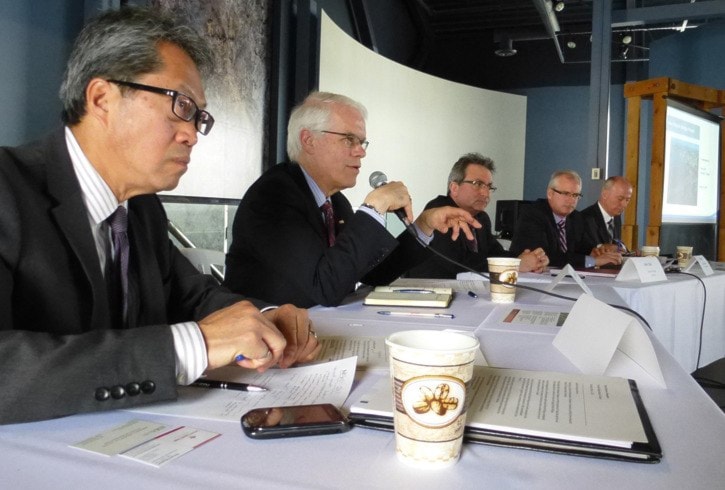A new, six-lane Pattullo Bridge is necessary to keep the region moving.
That was the main message from most of the speakers at the Fraser River Discovery Centre on Thursday to discuss the replacement of the 75-year-old span, an event co-hosted by the Surrey Board of Trade and the New Westminster Chamber of Commerce.
"This is a really important project," said TransLink roads manager Sany Zein. "It's going to determine transportation in the region for the next 100 years. It's a key corridor for movement in the region and for trade."
TransLink has targeted replacing the bridge by 2018, and would build it next to the existing span.
According to speakers Zein, City of Surrey transportation manager Paul Lee and Bernie Magnan of the Lower Mainland Chambers Transportation Panel, it's a vital link, filling an important niche between the Port Mann Bridge to the east and the Alex Fraser Bridge to the west.
"From Surrey's point of view, this bridge is essential. It's critical to the economic development of the city," said Lee, adding that the links to major routes on either side should be well connected. "If these connections are not made, traffic and trucks will infiltrate Surrey's neighbourhoods."
Zein predicted the bridge will continue to play a key role as the population and economy of both cities grows between 70 and 100 per cent over the next 30 years. Although more people will shift to alternate modes of transportation, vehicle traffic is still slated to grow 50 per cent, he said.
Increasing the Pattullo from four to six lanes has caused concern among many Royal City residents that it will pour more regional traffic onto local streets, but TransLink says the new outside lanes will ensure trucks have a dedicated lane to keep them to the perimeter on the truck routes, such as East Columbia.
"That will actually reduce infiltration of trucks onto non-truck routes in the city," Zein said.
Magnan said despite calls in New West to keep the Pattullo as a four-lane bridge, move it or even scrap it altogether, the Royal City can't escape its geographical legacy.
"It's unreasonable to expect this area to not continue to play its role as a transportation corridor and centre," Magnan said, adding that many of the jobs and warehouses are located south of the Fraser while a significant portion of the population still lives to the north.
"The replacement of the Pattullo is something that needs to happen."
Magnan said in terms of the area economy, there is also a strong need to replace the 100-year-old railway bridge next to the Pattullo to ensure more efficient movement of goods and passengers, complete the stalled North Fraser Perimeter Road project and implement a consistent regional tolling policy.
He said studies have shown congestion costs Metro Vancouver upwards of $1.3 billion a year.
New Westminster engineering director Jim Lowrie said truck traffic travelling from Deltaport to the TriCities area using the Pattullo Bridge could be significantly eased if the soon-to-open South Fraser Perimeter Road was linked at the Port Mann Bridge. Currently, it won't link up to Highway 1 until 176th Street (Highway 15) in Surrey.
But Zein said this is a technical impossibility.
"Engineers can do a lot, but there are a lot of things we cannot do. The SFPR is 50 metres below the Port Mann Bridge. They cannot be connected."
New Westminster has not been participating in TransLink's consultations on the bridge replacement, opting to consult with residents first within the context of updating its Master Transportation Plan.
TransLink said it spent much time reviewing other options for the Pattullo prior to embarking on public consultation this year—including looking at four-lane options and alternate locations for the bridge, and has consultated with New Westminster and Surrey all along the way.
But Lowrie said the transportation authority has gone about things the wrong way, presenting the issue as a done deal.
Public dialogue should have started a couple of years ago, he said, by framing it as a problem to be resolved collaboratively. In his wrap up, he asked attendees to look at an aerial map of New Westminster, with its 19th-century road network and urban form.
"Would you put a six-lane bridge there today if you were starting over?"
